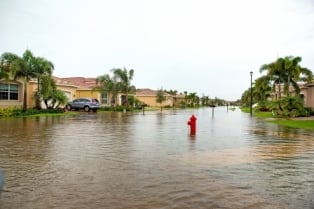A flood event for the record books overwhelmed the central and southern US in the waning days of December.
Unseasonable rainfall added to an already swollen Mississippi River, affecting nearly 20,000 square miles from southern Illinois to central Texas. Combined with an unexpected cold front, the storms claimed more than 40 lives and caused up to $1.2 billion in damage.
Just two months earlier, historic flooding in South Carolina had added another $1 billion to the flooding toll.
It’s a story that’s becoming all too familiar in flood-prone regions where sea levels keep rising and coastal development doesn’t stop. Yet despite the increased risk, more home and business owners are choosing to go without a critical piece of defense: flood insurance.
Flooding is the most common and costly natural disaster in the US, causing an average of $50 billion in economic losses each year, according to the Insurance Information Institute. But data from the National Flood Insurance Program reveals that the number of government-sponsored flood policies in force has plunged by nearly 10% in the past six years, from 5.7 million in 2009 to 5.1 million in 2015.
Even in South Carolina, which is one of the most insured states in the NFIP, fewer than 200,000 flood insurance policies are in force.
It’s a precipitous drop, and according to Robert Hartwig, economist and president of the Insurance Information Institute, it’s one that’s only going to get larger. “It’s sad to say, but that gap is going to increase,” Hartwig said during a recent presentation on uninsured risk with
Swiss Re. “People are reacting to price increases that have been put in place because [the NFIP] is broke.”
Those price increases are the result of the Biggert-Waters Act and subsequent legislation, which were designed to move toward more actuarially sound rates and ease some of the $24 billion debt the program incurred after Hurricane Katrina in 2005. Premium rates jumped 15% to 18% for new and renewal policies on primary homes, and 25% on secondary homes or homes that have suffered repeated losses.
Also contributing to consumer reticence toward insurance is a lack of significant flood damage, says Hartwig – even barring the events of this winter.
“Memories are short,” he says. “It’s been nearly 10 years since the last major hurricane in Florida – the longest span in history. And it does not take long for a gap between events for people to start questioning why they need this coverage.”
Even more worrying, a significant number of people may not even think to evaluate their risk due to a misunderstanding of flood coverage. The Insurance Information Institute’s Annual Pulse survey reveals that while 56% of those with a homeowner’s policy know their coverage does not include damage from flooding, 24% believe that it does. Another 19% say they don’t know.
These twin influences – high pricing and a lack of education – are paramount in insurance producers’ attempts to sell flood insurance amidst this drought of public interest.
On the first front, many are turning to the private market – like Dan Freudenthal’s Florida-based brokerage Agency Flood Resources – for alternative solutions.
“We are seeing that as NFIP costs increase, people are picking up the phone, calling their agent and saying, ‘What do you have as an alternative?’” says Freudenthal, who notes that the recent premium increases are the highest he’s seen in 15 years. “In the coming three years, a lot of interesting things will happen. The private flood market is about to burst.”
However, at last count, just five private insurers are taking on flood risk nationwide, and artificially depressed pricing from the NFIP is making it difficult to attract more carriers to the market.
“The NFIP rates have been woefully inadequate for a long time,” says NAPSLO executive director Brady Kelley. “Until NFIP gets real about pricing, the private market can’t compete for risks that currently flow through that program. That’s still quite a way off. There are still caps on rates, and a 25% increase doesn’t make them actuarially sound.”
Still, Kelley hopes private insurers – particularly surplus lines insurers – will be able to retain a foothold in the flood market. He and NAPSLO have long lobbied for technical changes to the Flood Disaster Protection Act of 1973 that would explicitly endorse private flood insurance issued by non-admitted insurers.
Non-admitted insurers are not barred from offering private flood insurance under the language of the 1973 legislation, but NAPSLO and others are looking to eliminate any possibility of blocking those carriers from the market.
“Surplus lines insurance provides an important option for consumers seeking coverage for unique or hard-to-place risks, including flood risks,” Kelley said when testifying before lawmakers in January.
“NAPSLO’s support for this [change] stems from our desire to preserve that choice for consumers.”
With such legislative clarification, increased education and actuarially sound NFIP rates, the flood insurance drought could finally come to an end.


